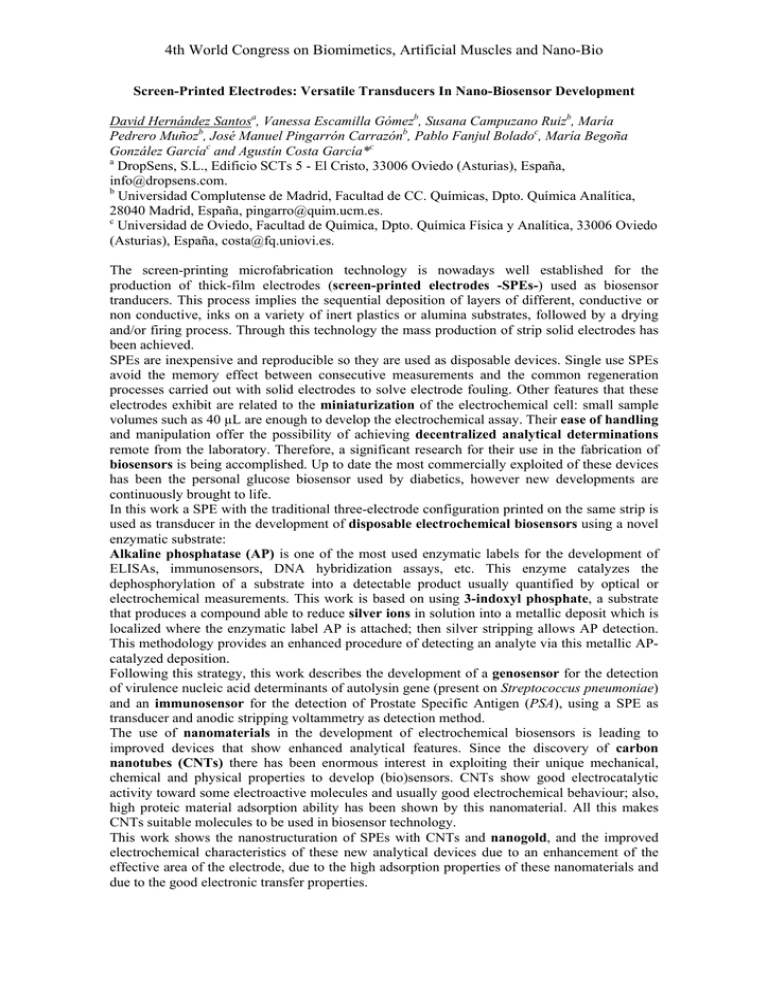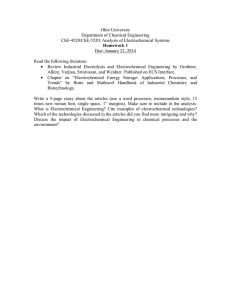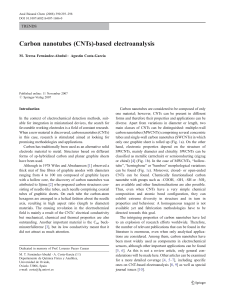Abstract title (font: Times New Roman, size: 11pt, bold capital letters
advertisement

4th World Congress on Biomimetics, Artificial Muscles and Nano-Bio Screen-Printed Electrodes: Versatile Transducers In Nano-Biosensor Development David Hernández Santosa, Vanessa Escamilla Gómezb, Susana Campuzano Ruizb, María Pedrero Muñozb, José Manuel Pingarrón Carrazónb, Pablo Fanjul Boladoc, María Begoña González Garcíac and Agustín Costa García*c a DropSens, S.L., Edificio SCTs 5 - El Cristo, 33006 Oviedo (Asturias), España, info@dropsens.com. b Universidad Complutense de Madrid, Facultad de CC. Químicas, Dpto. Química Analítica, 28040 Madrid, España, pingarro@quim.ucm.es. c Universidad de Oviedo, Facultad de Química, Dpto. Química Física y Analítica, 33006 Oviedo (Asturias), España, costa@fq.uniovi.es. The screen-printing microfabrication technology is nowadays well established for the production of thick-film electrodes (screen-printed electrodes -SPEs-) used as biosensor tranducers. This process implies the sequential deposition of layers of different, conductive or non conductive, inks on a variety of inert plastics or alumina substrates, followed by a drying and/or firing process. Through this technology the mass production of strip solid electrodes has been achieved. SPEs are inexpensive and reproducible so they are used as disposable devices. Single use SPEs avoid the memory effect between consecutive measurements and the common regeneration processes carried out with solid electrodes to solve electrode fouling. Other features that these electrodes exhibit are related to the miniaturization of the electrochemical cell: small sample volumes such as 40 µL are enough to develop the electrochemical assay. Their ease of handling and manipulation offer the possibility of achieving decentralized analytical determinations remote from the laboratory. Therefore, a significant research for their use in the fabrication of biosensors is being accomplished. Up to date the most commercially exploited of these devices has been the personal glucose biosensor used by diabetics, however new developments are continuously brought to life. In this work a SPE with the traditional three-electrode configuration printed on the same strip is used as transducer in the development of disposable electrochemical biosensors using a novel enzymatic substrate: Alkaline phosphatase (AP) is one of the most used enzymatic labels for the development of ELISAs, immunosensors, DNA hybridization assays, etc. This enzyme catalyzes the dephosphorylation of a substrate into a detectable product usually quantified by optical or electrochemical measurements. This work is based on using 3-indoxyl phosphate, a substrate that produces a compound able to reduce silver ions in solution into a metallic deposit which is localized where the enzymatic label AP is attached; then silver stripping allows AP detection. This methodology provides an enhanced procedure of detecting an analyte via this metallic APcatalyzed deposition. Following this strategy, this work describes the development of a genosensor for the detection of virulence nucleic acid determinants of autolysin gene (present on Streptococcus pneumoniae) and an immunosensor for the detection of Prostate Specific Antigen (PSA), using a SPE as transducer and anodic stripping voltammetry as detection method. The use of nanomaterials in the development of electrochemical biosensors is leading to improved devices that show enhanced analytical features. Since the discovery of carbon nanotubes (CNTs) there has been enormous interest in exploiting their unique mechanical, chemical and physical properties to develop (bio)sensors. CNTs show good electrocatalytic activity toward some electroactive molecules and usually good electrochemical behaviour; also, high proteic material adsorption ability has been shown by this nanomaterial. All this makes CNTs suitable molecules to be used in biosensor technology. This work shows the nanostructuration of SPEs with CNTs and nanogold, and the improved electrochemical characteristics of these new analytical devices due to an enhancement of the effective area of the electrode, due to the high adsorption properties of these nanomaterials and due to the good electronic transfer properties.





